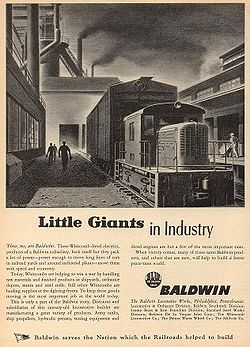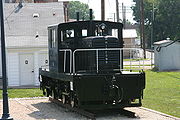
Whitcomb Locomotive Works
Encyclopedia

George Dexter Whitcomb
George Dexter Whitcomb an American manufacturer and founder of the town of Glendora, California.-Early life:Born in Brandon, Vermont to Dexter and Emily Whitcomb, George Dexter Whitcomb was the second of eight children. The family relocated to Franklin Mills, Ohio , where Dexter worked as a...
(1834-1914), of Chicago, Illinois, who started a modest machine shop in 1878, and began the manufacture of coal mining machinery, laying the foundation for the concern that became known as The Whitcomb Locomotive
Locomotive
A locomotive is a railway vehicle that provides the motive power for a train. The word originates from the Latin loco – "from a place", ablative of locus, "place" + Medieval Latin motivus, "causing motion", and is a shortened form of the term locomotive engine, first used in the early 19th...
Company.
Beginnings
Mr. Whitcomb designed and marketed the first successful coal miningCoal mining
The goal of coal mining is to obtain coal from the ground. Coal is valued for its energy content, and since the 1880s has been widely used to generate electricity. Steel and cement industries use coal as a fuel for extraction of iron from iron ore and for cement production. In the United States,...
machine. In 1892, this firm, then located at Orleans and Ohio Streets in Chicago
Chicago
Chicago is the largest city in the US state of Illinois. With nearly 2.7 million residents, it is the most populous city in the Midwestern United States and the third most populous in the US, after New York City and Los Angeles...
, Illinois was incorporated under the laws of Illinois
Illinois
Illinois is the fifth-most populous state of the United States of America, and is often noted for being a microcosm of the entire country. With Chicago in the northeast, small industrial cities and great agricultural productivity in central and northern Illinois, and natural resources like coal,...
as George D. Whitcomb Company. This industrialist, inventor and family man also founded Glendora, California
Glendora, California
Glendora is a municipality in Los Angeles County, California, United States, east of downtown Los Angeles. As of the 2010 census, the population of Glendora was 50,073....
, in 1887. Glendora is a suburb of Los Angeles, California
Los Angeles, California
Los Angeles , with a population at the 2010 United States Census of 3,792,621, is the most populous city in California, USA and the second most populous in the United States, after New York City. It has an area of , and is located in Southern California...
.
Mule
Mule
A mule is the offspring of a male donkey and a female horse. Horses and donkeys are different species, with different numbers of chromosomes. Of the two F1 hybrids between these two species, a mule is easier to obtain than a hinny...
s had long been used exclusively as the motive power in moving coal from the mines, but this method was expensive and unsatisfactory. Because of the insistent demand for a more economical method, experiments were conducted using for power—electricity, compressed air and rope drive. Gasoline engines were definitely a novelty in those early days, nevertheless Whitcomb decided the principle could be successfully applied to a small mine locomotive. In April, 1906 the first successful gasoline
Gasoline
Gasoline , or petrol , is a toxic, translucent, petroleum-derived liquid that is primarily used as a fuel in internal combustion engines. It consists mostly of organic compounds obtained by the fractional distillation of petroleum, enhanced with a variety of additives. Some gasolines also contain...
locomotive was built and installed in a large Central Illinois coal mine.

Move to Rochelle, Il
The year 1907 saw the company move to RochelleRochelle
Rochelle is a French name derived from rocher, which means "rock."Rochelle may refer to:-Places:*Rochelle, Florida*Rochelle, Georgia*Rochelle, Illinois*Rochelle, Texas*Rochelle, Virginia-People:...
, in Northern Illinois, where it continued to build quantities of gasoline powered locomotives for mine operation, both coal and metal. The reputation of the Whitcomb gasoline locomotive spread at such a rapid rate that, before long, greater production facilities were needed and in 1912 the plant was again moved to enlarged facilities elsewhere in Rochelle.
World War I
World War I
World War I , which was predominantly called the World War or the Great War from its occurrence until 1939, and the First World War or World War I thereafter, was a major war centred in Europe that began on 28 July 1914 and lasted until 11 November 1918...
saw the output of the Whitcomb plant almost entirely devoted to government orders. Hundreds of armor-plated locomotives were built for overseas service in France. These small 6-ton and 9-ton, narrow gauge locomotives proved highly efficient in trench warfare and they were used extensively in hauling needed supplies up to the front lines. In appreciation of their excellent contributions to the war effort, the Whitcomb Company was awarded a "Certificate of Merit" by the War Department.
Many new innovations in the locomotive field were being introduced during this period. The first explosion-proof electric mine locomotive was designed and built by Whitcomb in 1914 and after exhaustive tests the United States Bureau of Mines
United States Bureau of Mines
For most of the 20th century, the U.S. Bureau of Mines was the primary United States Government agency conducting scientific research and disseminating information on the extraction, processing, use, and conservation of mineral resources.- Summary :...
issued its “Permissibility Plate.” Whitcomb was the first builder of locomotives for underground work to receive such an endorsement. The first Whitcomb electric trolley locomotive was produced in 1921, and in 1929 Whitcomb designed and built the largest gasoline-electric locomotive that had then been offered to American railroads. This development was closely followed by the diesel-electrics which revolutionized the American transportation system.
Automobile Production
The company also manufactured an automobile known as the Partin and Palmer. A restored example is now displayed in the Flagg Township Historical Museum in Rochelle.Bought by Baldwin Locomotive Works
In 1929 the company was purchased by The Baldwin Locomotive WorksBaldwin Locomotive Works
The Baldwin Locomotive Works was an American builder of railroad locomotives. It was located in Philadelphia, Pennsylvania, originally, and later in nearby Eddystone, Pennsylvania. Although the company was very successful as a producer of steam locomotives, its transition to the production of...
, and the new owners, under George Houston sought a greater base of diversified holdings. From 1931 until 1940 the company was operated as the Whitcomb Locomotive Works, a subsidiary of The Baldwin Locomotive Works. On July 19, 1932 Whitcomb Locomotive Company acquired the Milwaukee Locomotive Manufacturing Company. During 1940, Baldwin completely took over the company and after that time it was operated as a division of Baldwin known as The Whitcomb Locomotive Company.

World War II
World War II, or the Second World War , was a global conflict lasting from 1939 to 1945, involving most of the world's nations—including all of the great powers—eventually forming two opposing military alliances: the Allies and the Axis...
Whitcomb built road switcher
Road switcher
A road switcher is a type of railroad locomotive used for delivering or picking up cars outside of a railroad yard. Since the road switcher must work some distance away from a yard, it needs to be able to operate at road speeds, it must also have high-visibility while it is switching, and it must...
s for military service in Europe and the Middle East. The United Kingdom ordered the first 52 in 1941 from Baldwin
Baldwin Locomotive Works
The Baldwin Locomotive Works was an American builder of railroad locomotives. It was located in Philadelphia, Pennsylvania, originally, and later in nearby Eddystone, Pennsylvania. Although the company was very successful as a producer of steam locomotives, its transition to the production of...
who allocated the order to Whitcomb. They were center-cab Bo-Bo locomotives built as Whitcomb type 65-DE-14, and were followed by variants 65-DE-14A and 65-DE-14B in 1942 and 1943. They served in the North African Campaign
North African campaign
During the Second World War, the North African Campaign took place in North Africa from 10 June 1940 to 13 May 1943. It included campaigns fought in the Libyan and Egyptian deserts and in Morocco and Algeria and Tunisia .The campaign was fought between the Allies and Axis powers, many of whom had...
and on military trains in Palestine and Lebanon, and then in the Italian campaign
Italian Campaign (World War II)
The Italian Campaign of World War II was the name of Allied operations in and around Italy, from 1943 to the end of the war in Europe. Joint Allied Forces Headquarters AFHQ was operationally responsible for all Allied land forces in the Mediterranean theatre, and it planned and commanded the...
.
From this design Whitcomb developed the 65-DE-19A for the US Army Transportation Corps. They were built in 1943 and 1944 and served in many theaters of operations including Great Britain, France and Belgium. After the war many were sold to civilian railways and industrial railways in the USA while others were sold to Canada, Cuba, Mexico and the Netherlands. However, the Dutch soon found theirs unsatisfactory and replaced both the diesel engines and the electric traction motors in the early 1950s.
Whitcomb continued to expand and progress after the war and the increased volume of business made it essential to expand storage and shipping facilities. A warehouse complete with the latest in material handling equipment was erected in 1947. A ten-ton overhead yard crane was installed to facilitate handling and storage of steel slabs and sheets. During 1948, a combination loading dock and locomotive test building was erected.
The end
In February 1952 locomotive production was shifted from Rochelle, Illinois to Baldwin’s Eddystone, Pennsylvania Works. Industrial locomotives continued to be built under the Whitcomb name at Eddystone through the end of December 1952, when the name was dropped. Any Whitcomb locomotives built after that time carried the B-L-H identification.The last Whitcomb locomotive manufactured at Rochelle
Rochelle
Rochelle is a French name derived from rocher, which means "rock."Rochelle may refer to:-Places:*Rochelle, Florida*Rochelle, Georgia*Rochelle, Illinois*Rochelle, Texas*Rochelle, Virginia-People:...
was shipped on January 4, 1952 (construction number 61189). It was a 25-ton diesel-electric locomotive delivered to the Central Procurement Agency of the Transportation Corps. This locomotive was lettered and numbered USN No. 65-00330. Production of the Whitcomb locomotive line came to an end in March, 1956 after producing approximately 5,000 locomotives.

